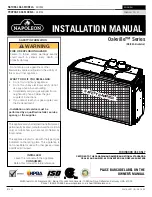
SuperiorFireplaces.us.com
126601-01_J
27
APPENDIX A
Draft Requirements
Your wood-burning appliance is dependent upon a properly func-
tioning chimney for optimum performance. It is important to match
the wood-burning appliance to the chimney. The chimney has two
functions:
1. It draws combustion air into the appliance (without air, no fuel
will burn) and
2. It exhausts combustion by-products. Your new appliance is what
is known as a “natural draft” appliance.
The appliance depends solely on the natural draft of the chimney
system to draw combustion air into the unit. Draft is the force that
moves air from the appliance up into the chimney. The amount of
draft in your chimney depends on the length of the chimney, local
geography, nearby obstructions and other factors. Too much draft
may cause excessive temperatures in the appliance (overfiring). Slow
or inadequate draft equals poor combustion and possible smoking
problems. The following are some conditions that may contribute
to poor chimney draft:
1. A chimney too large for your appliance.
2. A chimney with not enough height to produce adequate draft.
3. A chimney with excessive height (this may allow exhaust to cool
too much before exiting, which will stall the rate the exhaust exits).
4. Offsets in the venting system are too restrictive
(see Chimney
Guidelines
).
Inadequate draft will cause the appliance to leak smoke into the room
through the wood-burning appliance and the chimney connector joints.
Excessive draft may cause an uncontrollable burn or a glowing red
appliance or chimney part.
Overfiring Damage -
If the appliance or chimney connector glows,
you are overfiring. Other symptoms may include: Cracking, warping
or burning out of components, plated accessories may turn color,
appliance glass may develop a haze, which will not come off with
cleaning.
Overfiring of a appliance is a condition where excessive tempera-
tures are reached, beyond the design capabilities of the appliance.
The damage that occurs from overfiring is not covered under the
manufacturer’s limited warranty.
Also see Troubleshooting on Page 28.
Selecting the Proper Venting System
The appliance is merely one component of a larger system. The
other equally important component is the venting system. This is
necessary for achieving the required flow of combustion air to the fire
chamber and for safely removing unwanted combustion by products
from the appliance.
If the venting system’s design does not promote these ends, the system
may not function properly. Poorly functioning venting systems may
create performance problems as well as be a safety hazard.
A draft
test should read greater than .04’ W.C. (inches water column) and
less than .08” W.C.
As per NFPA-211 standard, the installer must
WARNING
Neither the manufacturer nor the seller warrants “smoke
free” operation nor are we responsible for inadequate
system draft caused by mechanical systems, general
construction conditions, inadequate chimney heights,
adverse wind conditions and/or unusual environmental
factors or conditions beyond our control.
take into account all variables within the installation and install the
appliance in such a manner that satisfies the draft requirements of
the appliance. See Chimney Guidelines to assist you in selecting the
proper venting system for your installation.
American National Standards Institute ANSI/NFPA 211, Standard
for Chimneys, Fireplaces, Vents, and Solid Fuel-Burning Appli-
ances - See Draft Section:
A chimney or vent shall be so designed
and constructed to develop a flow sufficient to completely remove all
flue and vent gases to the outside atmosphere. The venting system
shall satisfy the draft requirements of the connected appliance in
accordance with the manufacturer’s instructions.
Chimney Guidelines:
• In well insulated and weather tight homes, it may be difficult to
establish a good draft up your chimney. The poor draft is caused
by a shortage of air in the house. In this situation an Outside Air
Kit may need to be installed (See Negative Pressure Warning be-
low and Outside Combustion Air in the Installation and Operation
manual).
Negative Pressure Warning
These appliances are not designed to be operated in a negative
pressure. In very airtight homes with large kitchen exhaust fans,
furnace cold air returns, fresh air exchange systems and any other
air system in close proximity to the heating appliance may create a
negative pressure in the same room as the heating appliance. This can
create dangerous back drafting of the appliance and chimney joints,
drawing combustion by-products into the home. Be sure your home
has adequate makeup air to eliminate negative pressures caused by
the above-mentioned sources. Outside air connected to the appliance
probably will not resolve such a problem as the appliance is not the
source of negative pressure. IHP accepts no liability for damages
resulting from negative pressures described here.
Ventilation Requirements -
Provide adequate air for combustion.
The fresh air requirements of this appliance must be met within the
space where it will be installed. Ventilation is essential when using
a solid-fuel-burning appliance. In well insulated and weather tight
homes, it may be difficult to establish a good draft up the chimney
(caused by a shortage of air in the home). The lack of air is caused
by many common household appliances which exhaust air from the
home (such as a furnace, heat pump, air conditioner, clothes dryer,
exhaust fans, fireplaces, and other fuel burning appliances). Also, the
combustion process of this appliance uses oxygen from inside the
dwelling. If the available fresh air delivery in the dwelling is insufficient
to support the demands of these appliances, problems can result
(i.e. excessive negative pressure can develop in the dwelling which
will affect the rate at which this appliance can draft thus resulting
in performance problems or smoking. To correct this problem it
may help to open a window (preferably on the windward side of the
house) or install an outside air kit.






































